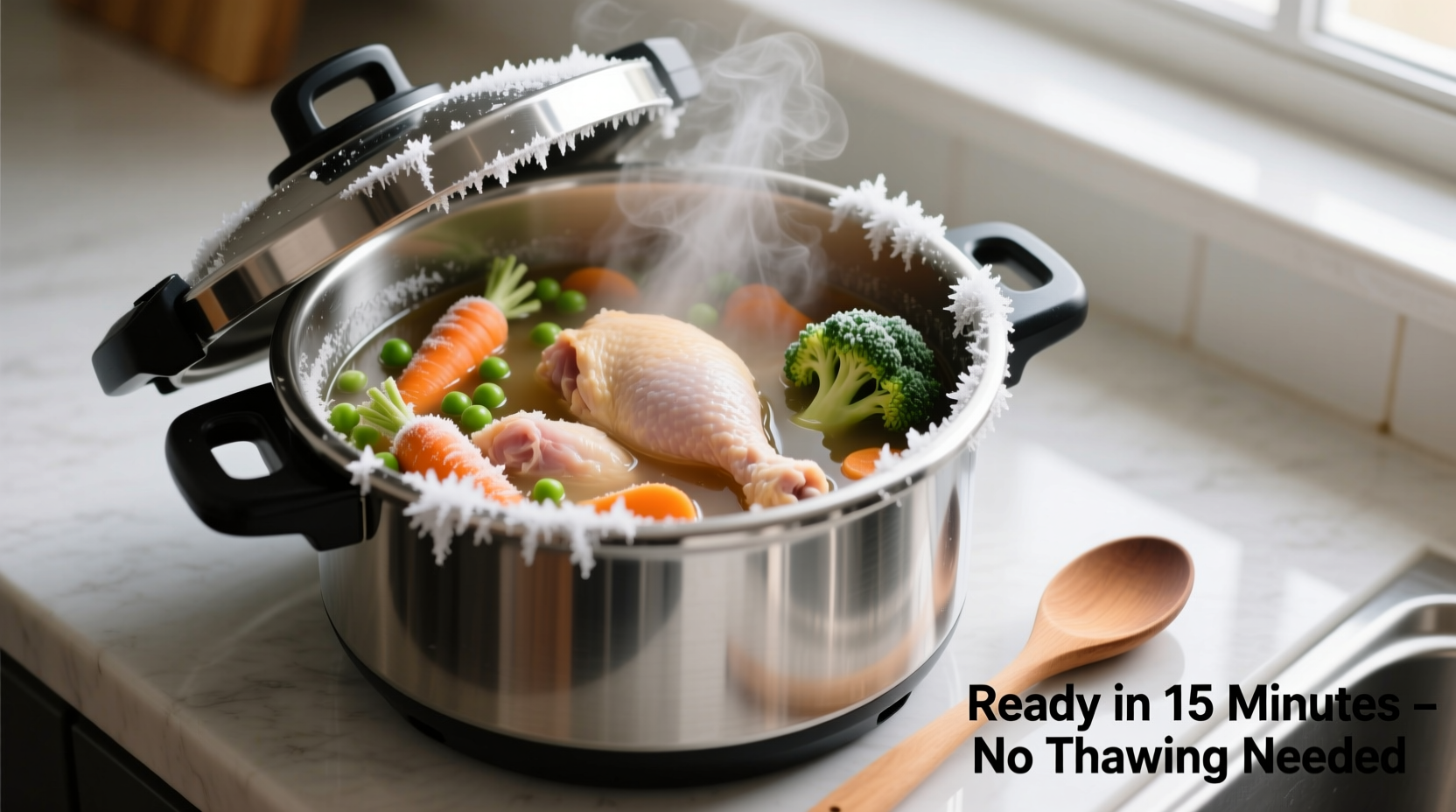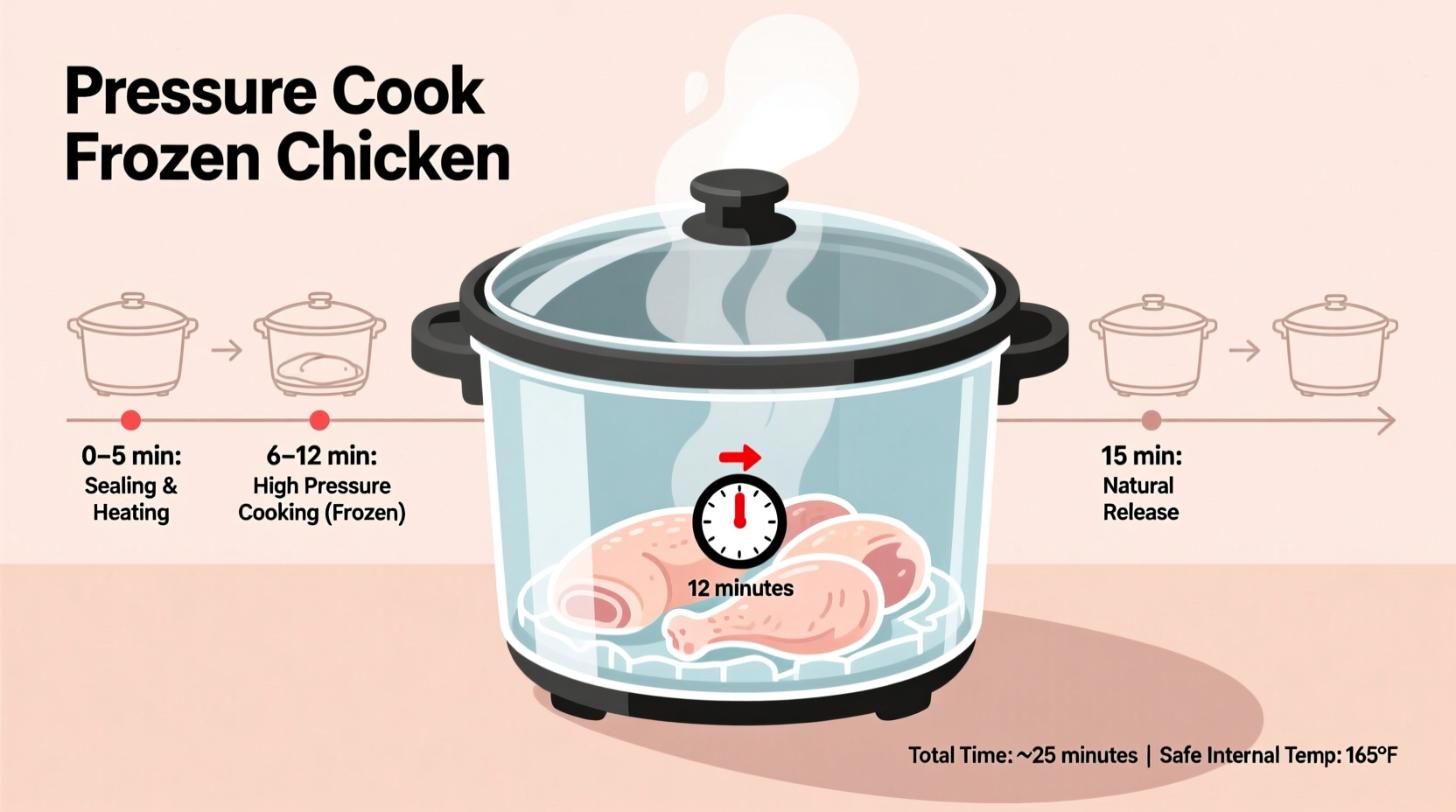Pressure cook frozen chicken breasts for 20-22 minutes at high pressure with a 10-minute natural release for safe, tender results. Bone-in pieces require 26-28 minutes, while thighs need 18-20 minutes. Always add 1 cup of liquid and verify internal temperature reaches 165°F (74°C) before serving.
The Complete Guide to Pressure Cooking Frozen Chicken Safely
When you're staring at frozen chicken in your freezer with dinner plans looming, pressure cooking offers the fastest path to a safe, delicious meal. Unlike traditional methods requiring thawing, modern electric pressure cookers like Instant Pot can transform frozen poultry into succulent dishes in under 30 minutes—without compromising safety. This guide delivers precise timing, safety protocols, and pro techniques verified by food scientists and culinary experts.
Why Pressure Cooking Works for Frozen Chicken
Pressure cooking's superheated steam environment penetrates frozen proteins 3x faster than conventional methods. The USDA confirms that cooking frozen meats directly is safe when proper temperature guidelines are followed, eliminating the bacterial growth risk associated with partial thawing. Modern electric pressure cookers maintain precise temperature control, preventing the "danger zone" (40°F-140°F) exposure that makes stovetop frozen cooking risky.
| Chicken Cut | Size/Weight | Pressure Time | Natural Release | Total Time |
|---|---|---|---|---|
| Chicken breasts (boneless) | 1-1.5 lbs | 20-22 min | 10 min | 35-37 min |
| Thighs (bone-in) | 2-2.5 lbs | 26-28 min | 15 min | 45-48 min |
| Drumsticks | 1.5-2 lbs | 18-20 min | 10 min | 33-35 min |
| Whole chicken | 3-4 lbs | 28-30 min | 20 min | 55-60 min |
Source: USDA Food Safety and Inspection Service pressure cooking guidelines (2023 update)
Step-by-Step Cooking Protocol
Preparation Essentials
Before pressing start, follow these critical steps:
- Liquid requirement: Always add minimum 1 cup broth or water (never less)
- Arrangement: Place chicken in single layer without stacking
- Seasoning: Apply salt after cooking (frozen surfaces won't absorb seasonings)
- Trivet use: Elevate chicken above liquid for more even cooking

Safety Verification Process
Never skip these food safety checks:
- Confirm internal temperature reaches 165°F (74°C) using instant-read thermometer
- Check for uniform texture (no ice crystals or frozen centers)
- Verify juices run clear when pierced
- Discard any pieces with off-odors despite proper cooking
The National Center for Home Food Preservation emphasizes that frozen chicken must reach 165°F within 2 hours of starting cook time to prevent bacterial growth. Modern pressure cookers consistently achieve this within 30 minutes, making them significantly safer than slow cookers for frozen proteins.
When NOT to Cook Frozen Chicken
Understanding these critical limitations prevents dangerous mistakes:
- Stuffed poultry: Never cook frozen stuffed chicken (bacteria risk in stuffing)
- Pre-marinated products: Avoid frozen chicken with sugar-based marinades (causes burning)
- Large whole birds: Chickens over 4 lbs require partial thawing first
- Old frozen stock: Discard chicken frozen beyond 6 months for quality reasons
Food safety experts at the USDA warn that attempting to pressure cook oversized frozen poultry creates uneven heating zones where harmful bacteria like salmonella can survive. Always follow weight guidelines strictly.
Pro Techniques for Perfect Results
Professional chefs use these methods to elevate frozen chicken dishes:
- Quick-sear finish: Brown cooked chicken under broiler for 2-3 minutes
- Flavor boost: Add 2 tbsp vinegar to cooking liquid to enhance tenderness
- Moisture retention: Let chicken rest 5 minutes after natural release before opening
- Stock creation: Use cooking liquid as base for instant gravy or soup
Unlike older pressure cooker models requiring careful pressure monitoring, modern electric units automatically regulate temperature and pressure. This technological evolution, documented by Consumer Reports' 2024 kitchen appliance study, has made frozen protein cooking significantly safer and more accessible for home cooks.
Troubleshooting Common Issues
Resolve these frequent problems:
- Burn notice: Increase liquid to 1.5 cups and deglaze pot thoroughly
- Dry texture: Reduce cooking time by 2 minutes for subsequent batches
- Uneven cooking: Cut large breasts horizontally before cooking
- Metallic taste: Avoid cooking acidic ingredients with frozen chicken
Remember that cooking times vary slightly between pressure cooker brands. Always consult your specific model's manual for manufacturer-recommended frozen food settings, as newer models often include dedicated frozen-to-cook functions that optimize timing automatically.











 浙公网安备
33010002000092号
浙公网安备
33010002000092号 浙B2-20120091-4
浙B2-20120091-4